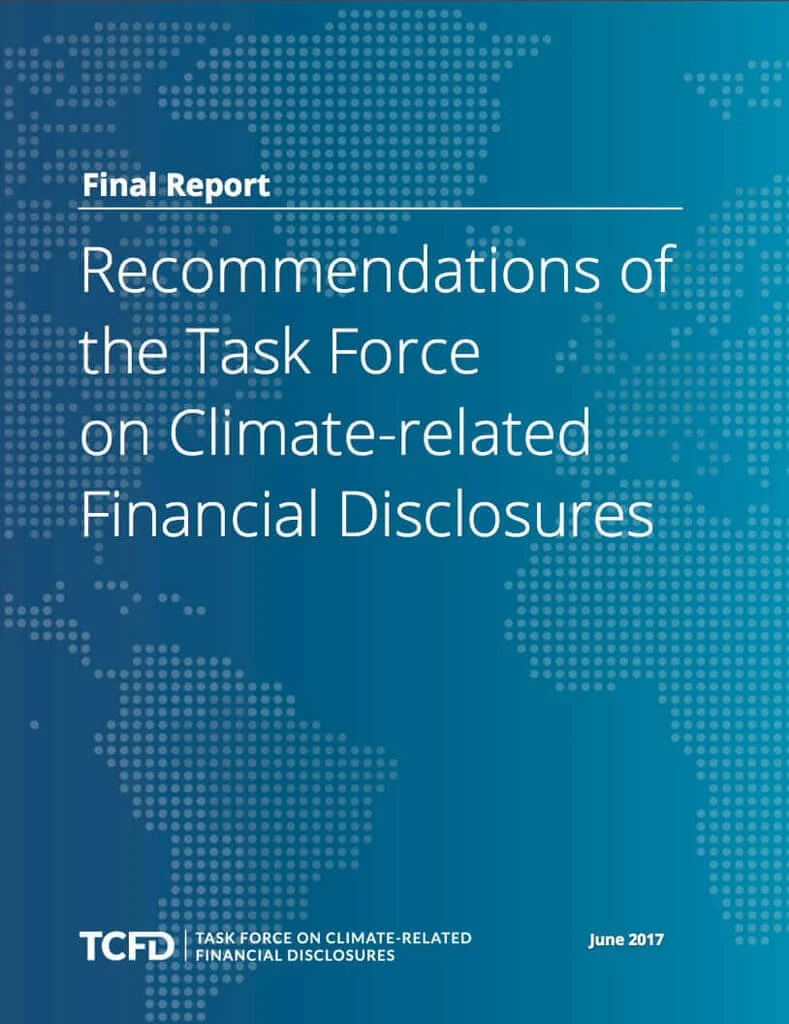TCFD Reporting and How to Implement it
This article was put together by TT Impact Strategies (TTIS)
It talks about TCFD reporting as a concept and its relevance; its necessity and who it should be applied by. Lastly, the article outlines how TCFD reporting works and provides a short guide on how to implement it sustainably in an organization.
The reader will learn:
a. That TCFD reporting is about climate change’s impact on companies.
b. That TCFD reporting ensures a smooth transition within organisations in the current and future context of climate change.
c. The core areas of disclosure.
d. The necessity and benefits of the economic sector to assess climate risks in relation to its management and finances, and their incorporation of TCFD reporting.
e. Steps to implement TCFD reporting effectively.
TCFD Reporting and Implementation
With climate change no longer being far-away concern, non-action costs outweigh the cost of investing into the assessment of climate-related needs (risks) and benefits (opportunities). Corporate social responsibility or specific sustainability reports have been around for a while, TCFD however goes further and makes climate-related needs and benefits integral to company operations and their financial reporting.
TCFD reporting is not about your company’s impact on climate change but about climate change’s impact on you. It has been developed as an approach for companies to assess whether climate risk is appropriately priced at their company.
Essentially it asks companies to provide disclosure and link climate-related information with financial information; to integrate climate-related issues into strategical and financial decisions-making. Thereby, to prepare companies for the transitions that will have to be made, given the rising climate. This in a way to that is of mutual beneficence - it’s better for the planet as well as business.
Introduction to TCFD Reporting as a concept
Where does it come from and who is it to be applied?
In 2015, the Financial Stability Board (FSB) established the Task Force on Climate-related Financial Disclosures (TCFD), expressing the need for persistent, comparable, and reliable corporate disclosure of climate-related information. In 2017, TCFD published recommendations for climate-related financial risk disclosures in mainstream corporate reporting. These are structured around four core areas which interlink and inform one another and represent how organisations operate: governance, strategy, risk management, and metrics and targets.
The concept is built to cover both financial and non-financial sectors. Strongly encouraged to adopt the strategy are companies with listed debt or equity, asset managers and asset owners. This means to reassure more informed investing and lending for debt and equity providers, responsible and sustainable insurance underwriting for insurers and enabling interested stakeholders to consider the risks and opportunities to make most informed decisions. Further, it provides information for assets managers and asset owners to manage their assets effectively and future proofed.
Why is this approach needed?
The climate change agenda is receiving continued and increasing attention at the government and public level. With the temperature rising, the risks of climate change and a trend to a lower carbon economy are becoming more and more prevalent to organisations. As necessary as that is, it will bring vast changes across the economic sector. Risks and opportunities for business spring from climate change, now and in the future. However, actors need to have a clear image and strategy of how companies align with those dynamics and flourish with them instead of struggle. The changing environment, the shift in regulations, the emergence of new technologies and the changing costumer behavior will have effects on economic life. Therefore, climate-related financial information needs to be accessible and direct effects on companies and businesses analysed and reported on. Not only to flourish with current and future changes but to assure transitions within companies and the overall economic sector.
What is special about TCFD reporting?
TCFD reporting distinguishes itself from other forms of for example sustainable goals or corporate responsibility aims because it focuses on climate changes’ impact on companies themselves. These must realise the necessity to assess the needs (risks) and benefits (opportunities) they are exposed to, in order to not fall behind now or in the future. With climate-related risks posing an existential threat to the long-term resilience of investment portfolios and with climate-regulating frameworks gaining a momentum, there is a necessity for an eye on companies and investors’ climate risk management practices and disclosures.
Financial Reporting Council (FRC) published an extensive Climate Thematic Review 2020 and expressed that this is done best when the report demonstrates: “specific details about [the impact of climate change on] product lines, services and investments” as well as it is “linking climate-related risks and opportunities to [particular] business areas”.
Four Core areas addressed in TCFD reporting
The framework of TCFD reporting is specified to four core areas for companies to disclose their approach at managing the climate’s impact and financial implications. These are: Governance, strategy, risk management, and metrics and targets. Companies shall orient their TCFD reporting within those core areas. In terms of governance, companies are asked to describe their management and the boards’ role in how they assess climate-risks and opportunities. In terms of strategy, companies should provide comment on the impact of climate-related risks and opportunities on the business and its strategy. Essentially on their strategy’s resilience, taking into account different climate scenarios. In terms of risk management, companies should identify, assess, and manage climate-related risks and demonstrate how such an approach is integrated into the business risk management programme. Lastly, metrics and targets should be used to assess and manage climate-related risks and opportunities.
TCFD reporting’s clear-cut benefits
Not only does TCFD reporting smoothen present and future transitions by growing the awareness of climate-risks and opportunities but it portrays transparency and builds trust for investors and lenders. TCFD reporting provides benefits such as:
“Easier or better access to capital by increasing investors’ and lenders’ confidence that the company’s climate-related risks are appropriately assessed and managed;
More effectively meeting exiting disclosure requirements to report material information in financial filings;
Increased awareness and understanding of climate-related risks and oppertunities within the company resulting in better risk management and more informed strategic planning; and
Proactively addressing investors’ demand for climate-related information in a framework that investors are increasingly asking for, which could ultimately reduce the number of climate-related information requests received.” TCFD taskforce, October 2019, Overview of Recommendations and Status Report.
TCFD reporting is not legally required yet but is required from you if you want to be ahead and build a business resilient to risks from climate change.
A short guide to implement TCFD reporting effectively
The baseline of TCFD reporting is disclosure. Although the TCFD taskforce has provided recommendations for TCFD reporting implementations, implementation practices vary to some degree on the organisation’s size, structure and operating mechanism. In order to lay the groundwork for meaningful disclosure on climate-related information, climate assessment, monitoring and management has to be incorporated into the organisation’s operating routine. This can be split into 10 interrelated steps and roughly into two groups.
First steps
1. First, direct and executive leadership that sets a clear tone of approach is crucial in effective management of climate-related risks and opportunities.
2. Audit and risk committees should directly link climate-related issues into strategic and financial decisions.
3. On the board level, management processes concerning sustainability, governance, finance and compliance should be delegated.
4. Further, climate changes’ relations to revenues, expenditures, assets, liabilities and financial capital are to be assessed. Therein, the impact of physical consequences as well as transitional changes due to climate change. Such understanding and communication to investors will enable more decision-useful information for investment, lending and insurance underwriting decisions.
5. The company should assess the business’ resilience against potential scenarios.
6. Already existing enterprise-level and other risk management processes should integrate climate risks.
Further steps
7. Investors and their feedback should be taken into consideration in order to assure and maintain the generation of disclosure that is useful in decision-making.
8. It is helpful to use existing tools to exercise reporting on climate-related information, such as such as the CDP questionnaire, CDSB Framework, and the SASB standards, to catalyse the implementation of TCFD reporting.
9. Quality assurance and compliance approaches for climate-related financial information for finance, management, and governance disclosures should be maintained. Even if it is not assured, it should be prepared if so.
10. A company should scrutinise the existing structure of the annual reporting and see how the recommendations from risk discussions, management discussions and analysis, and the governance section can be incorporated and connected. The key element being that TCFD reporting is that climate-related financial information is incorporated in mainstream reports.
Key and conclusory points
The key take-away is that climate-change is on shores and currently, as well as in the future, has impacts on the economic sector. Let alone that the economic sector has effects on climate change. Climate change’s direct impact and the government’s and public’s response, companies need to adapt and assess the risks and opportunities in order to ensure a smooth transition, however way such is ahead.
Within TCFD reporting, the most important aspect is to provide meaningful disclosure, information on how an organisation approaches such the climates’ impacts. However, that is also the main issue. It will obtain time and need a lot of internal buy-in within companies to implement TCFD reporting into business routines. Given the likely future with climate change on the rise, companies are strongly recommended to implement TCFD reporting, nonetheless. It is of crucial importance to acknowledge the current climate situation and think ahead, and thereby ensure the needed transition to be made.
Direct guidance for implementation
With the widespread adoption of the TCFD recommendation and reporting as an approach, many regard it to be mandatory in the very near future. Hence it is on various levels beneficiary to have a serious look into it, besides the before-mentioned necessity for resilience and the specific approaches’ benefits.
Beside guidelines there are also services such as for example ITPEEnergised and Orbis Advisory that aspire to help companies implement TCFD reporting. Their help includes services such as Gap Analysis, benchmarking, KPI setting, stakeholder engagement, GHG reporting, materiality assessment, scenario analysis, science-based target, and PRI and CDP alignment.



